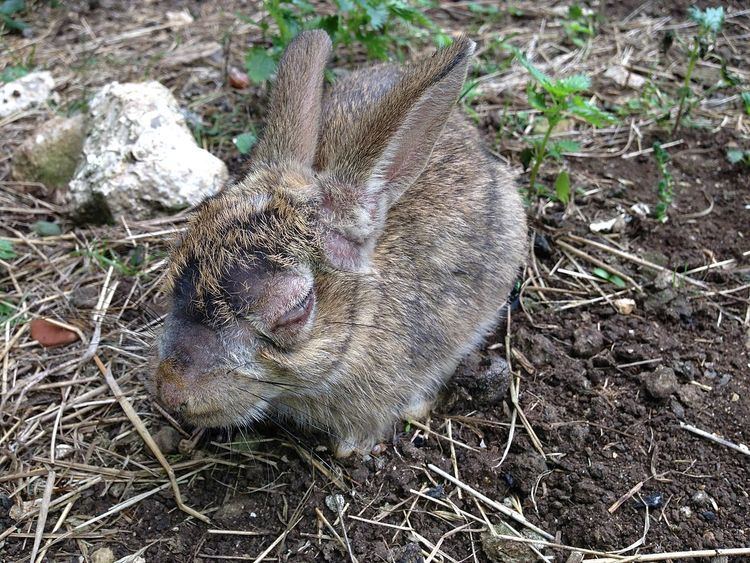 | ||
Myxomatosis (sometimes shortened to "myxo" or "myxy") is a disease that affects rabbits, caused by the myxoma virus. It was first observed in Uruguay in laboratory rabbits in the late 19th century. It was introduced into Australia in 1950 in an attempt to control the rabbit population (see Rabbits in Australia). Affected rabbits develop skin tumors, and in some cases blindness, followed by fatigue and fever; they usually die within 14 days of contracting the disease.
Contents
- Effects of the disease
- Treatment
- Use as a population control agent
- Australia
- France
- United Kingdom
- New Zealand
- Use of vaccine
- Natural resistance
- References
The disease is spread by direct contact with an affected animal or by being bitten by fleas or mosquitoes that have fed on an infected rabbit. The myxomatosis virus does not replicate in these insect hosts, but can be physically carried by an insect's mouthparts, i.e. from an infected rabbit to another susceptible animal. Due to the potential of insect vector transmission, pet rabbits may be susceptible in enzootic areas and vaccination is highly recommended.
Effects of the disease
In rabbits of the genus Sylvilagus (cottontail rabbits) living in the Americas, myxomatosis causes only localized skin tumors, but the European rabbit (Oryctolagus cuniculus) is more severely affected. At first, normally the disease is visible by lumps (myxomata) and puffiness around the head and genitals. It may progress to acute conjunctivitis and possibly blindness; however, this also may be the first visible symptom of the disease. The rabbits become listless, lose appetite, and develop a fever. Secondary bacterial infections occur in most cases, which cause pneumonia and purulent inflammation of the lungs. In cases where the rabbit has little or no resistance, death may take place rapidly, often in as little as 48 hours; most cases result in death within 14 days. Often the symptoms like blindness make the infected rabbit more vulnerable to predators.
Treatment
In pet rabbits, myxomatosis can be misdiagnosed as pasteurellosis, a bacterial infection which can be treated with antibiotics. By contrast, there is no treatment for rabbits suffering from myxomatosis, other than palliative care to ease the suffering of individual animals, and the treatment of secondary and opportunistic infections, in the hopes the treated animal will survive. In practice, the owner is often urged to euthanize the animal to end its suffering.
Use as a population control agent
After its discovery in 1896 in imported rabbits in Uruguay, a relatively harmless strain of the disease spread quickly throughout the wild rabbit populations in South America.
Australia
In Australia, the virus was first field-tested for population control in 1938. A full-scale release was performed in 1950. It was devastatingly effective, reducing the estimated rabbit population from 600 million to 100 million in two years. However, the rabbits remaining alive were those least affected by the disease. Genetic resistance to myxomatosis was observed soon after the first release, and descendants of the survivors acquired partial immunity in the first two decades. Resistance has been increasing slowly since the 1970s; the disease now kills about 50% of infected rabbits. In an attempt to increase that rate, a second virus (rabbit calicivirus) was introduced into the rabbit population in 1996.
France
Myxomatosis was introduced to France by the bacteriologist Dr. Paul Armand Delille, following his use of the virus to rid his private estate of rabbits in June 1952. (He inoculated two of the rabbits on his land). Within four months the virus had spread 50 km; Armand suspected this was due to poachers taking infected rabbits from his estate. By 1954, 90% of the wild rabbits in France were dead. The disease spread throughout Europe.
United Kingdom
The disease reached the UK in 1953. The first outbreak in the UK to be officially confirmed was in Bough Beech, Kent in September 1953. It was encouraged in the UK as an effective rabbit bio-control measure; this was done by placing sick rabbits in burrows, though this is illegal in the UK. As a result, it is understood that more than 99% of rabbits in the UK were killed by the outbreak. In some cases, hunters would target infected rabbits to mercifully dispatch the animal.
New Zealand
Myxomatosis was introduced in New Zealand in the early 1950s as a form of pathogenic control. Unlike in Australia, it failed to become established because of a lack of a suitable spreading organism.
Use of vaccine
A vaccine is available for pet rabbits (ATCvet code: QI08AD02 (WHO)). The vaccine is not allowed to be used in Australia because the live virus in the vaccine has the potential to spread into the wild rabbit population which could result in wild rabbit immunity to myxomatosis. If this happened, there would be a dramatic increase in the number of wild rabbits in Australia, which would cause major damage to the environment and economic losses. Many pet rabbits in Australia continue to die from the disease due to their lack of immunity. There is at least one campaign to allow the vaccine for domestic pets.
In the UK a live combination vaccine, Nobivac Myxo-RHD, made by MSD Animal Health, has since 2011 become available. Its active ingredient is a live myxoma-vectored RHD virus strain 009 and it offers a duration of immunity of 1 year against both RHD and myxomatosis.
Natural resistance
The development of resistance to the disease has taken different courses. In Australia, the virus initially killed rabbits very quickly – about 4 days after infection. This gave little time for the infection to spread. However, a less virulent form of the virus then became prevalent there, which spread more effectively by being less lethal. In Europe, many rabbits are genetically resistant to the original virus that was spread. The survival rate of diseased rabbits has now increased to 35%, while in the 1950s it was near zero.
Hares are not affected by Myxomatosis, but can act as vectors.
